On this page we outline the process to follow to obtain a European patent when a previous (Dutch) patent application has already been filed.
- Choice for a European patent
- Wait for approval (Order confirmation)
- Filing
- Reporting European search report
- Publication European Patent Application
- Request for examination
- Waiting for communication from the European Patent Office
- Reporting and responding to communication
- Intention to grant and formalities
- Patent grant and country selection
- End of opposition period for (third) parties
- Legenda
Choice for a European patent

If a (Dutch) patent application has already been filed for the invention, it can – possibly in adapted and/or translated form – be filed as a European patent application. During the priority year of the previous application, we will discuss the possibilities with you.
If no previous patent application has been filed for the invention, we start with an intake, in which we discuss the invention. This can be done by video calling, but also by e-mail or by telephone, depending on what the circumstances require. During the conversation, we ask what you think is new about the invention and we indicate whether that invention is suitable for patent application, and whether, given what already exists in the field of the invention, there is a chance has success. If it is not known exactly what already exists, we can decide to do an investigation first. The central question to answer is “what exactly do you want to be able to ban your competitor?”. Because obtaining an exclusive right is the main purpose of a patent.
After the intake, we will send an order confirmation stating what we are going to do and for what amount, and as soon as we have received approval, we will get to work. The order confirmation and the amounts stated therein are valid for one month.
Wait for approval (Order confirmation)

If you opt for a European patent application with invocation of priority from a previous application, we will send you an order confirmation stating what we are going to do and for what amount. As soon as we have received approval, we will get to work. The order confirmation and the amounts stated therein are valid for one month.
Filing
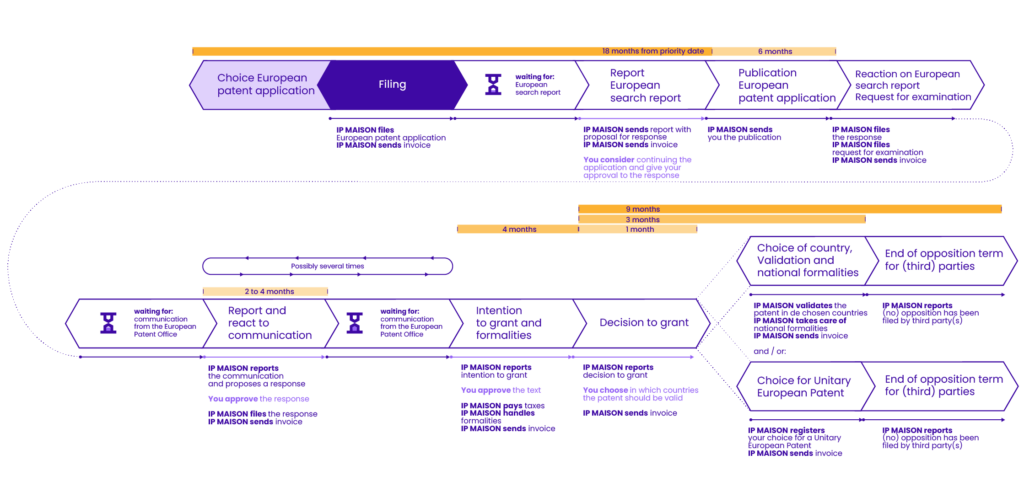
As soon as you agree, we will submit the patent application to the European Patent Office. We authorize the debiting of the due taxes from our deposit account. You will receive a submission confirmation from us and we will send an invoice for our work.
Then we have to wait for the results of the novelty search to be carried out by the European Patent Office.
Reporting European search report
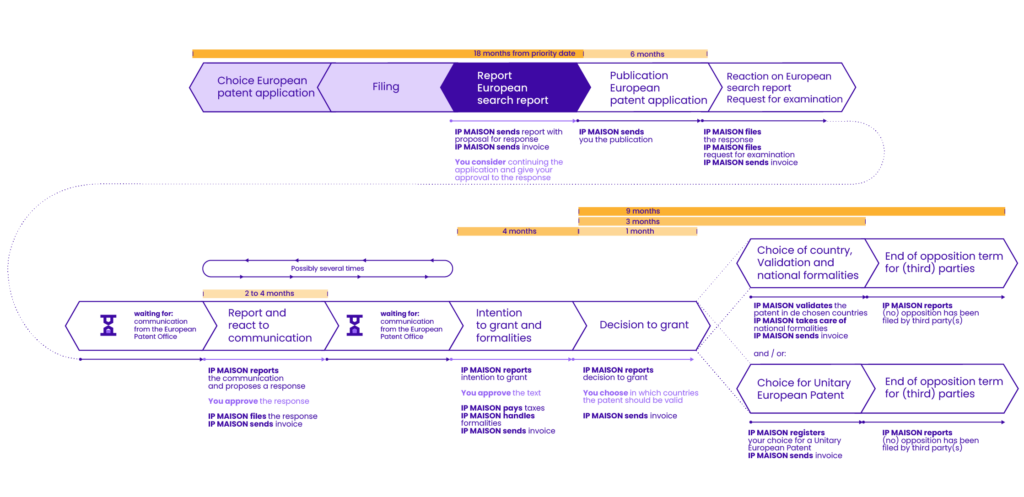
After the application has been filed, the European Patent Office carries out a novelty search. We usually receive the results of this within a few months after filing the patent application. These results consist of publications (patent publications and/or other documents) and an opinion of the examiner who conducted the research. To continue with the procedure, a so-called request for examination must be submitted and – unless there is no objection whatsoever – it is mandatory to respond to this novelty search.
We study the publications and the opinion, and we send you a report in which we also give our opinion on the relevance of the publications found, and indicate how we propose to respond to the examiner‘s opinion. This can be by making changes to the patent application, or by (only) putting forward arguments.
Publication European Patent Application
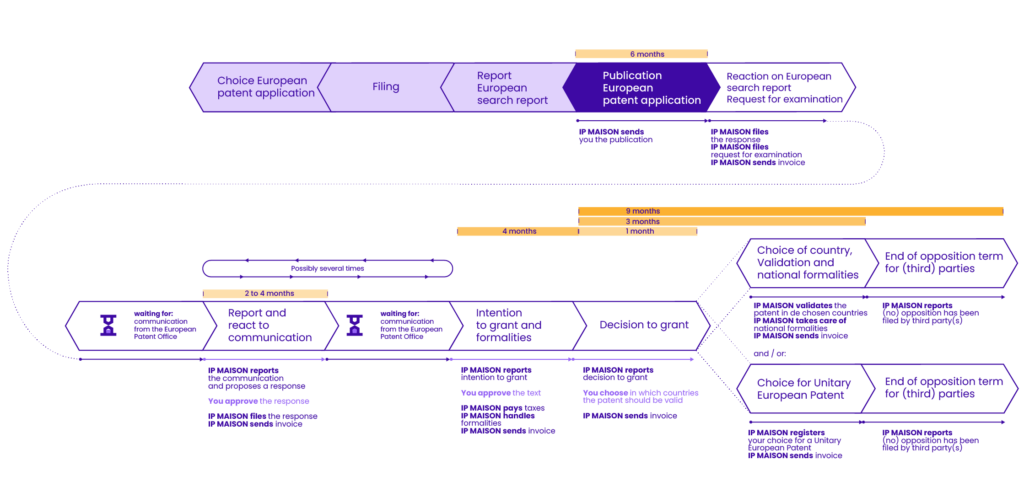
The European patent application is published 18 months after the filing of the previous application. We will send you the published patent application with, if already available, the results of the European search report.
Request for examination
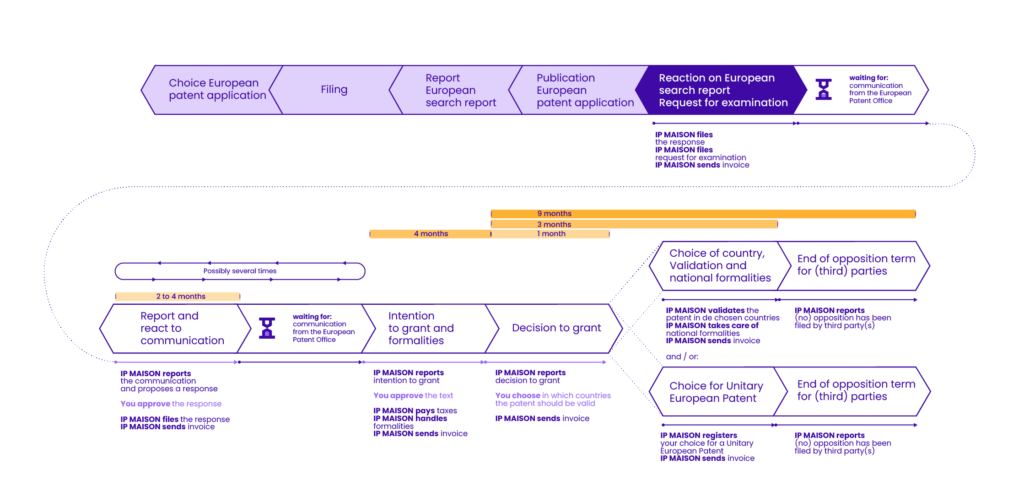
If the results of the novelty search were positive and you agree with the proposed response, we must submit it no later than six months after publication of the European patent application, together with the request for examination.
The so-called designation fee designation fee is also to be paid, with which we indicate that we are applying for the patent for all countries participating in the European patent treaty, and whereby an option can also be taken on a number of countries that do not fully participate in the treaty.
Waiting for communication from the European Patent Office
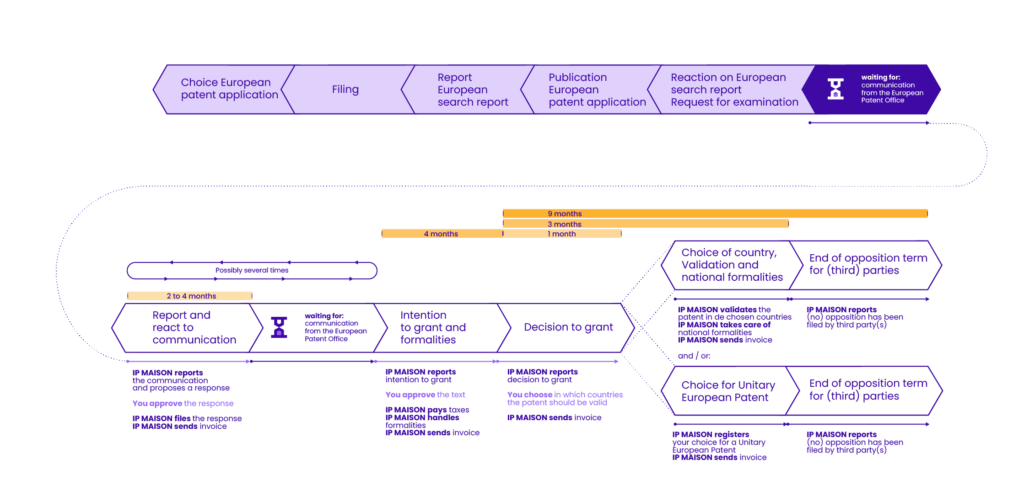
After the request for examination has been submitted, a communication from the European patent office is awaited. There is no set time frame for this, and in practice it can take anywhere from a few months to a few years. If we believe that it is taking too long, we can submit a request – stating the reason – to speed up the procedure.
Reporting and responding to communication
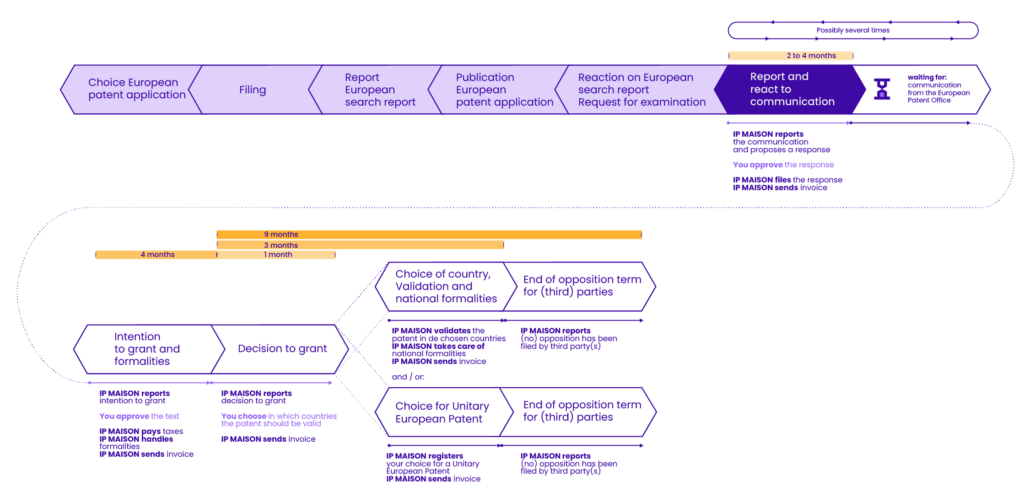
The communication is a letter in which the examiner of the European Patent Office responds to the request for examination, including the arguments submitted and any amendments to the application.
As a rule, such a communication again contains (limited) objections, but if possible the examiner also indicates whether there is a combination of claims that he considers grantable. This then has to be responded to again and then it is again a matter of waiting for a communication from the European patent office.
In the relatively rare case that the examiner is completely unwilling to grant a patent after a number of written rounds, a hearing can be requested, in which the opportunity is given to explain the invention in more detail. The result will be announced immediately at the end of that session.
Intention to grant and formalities
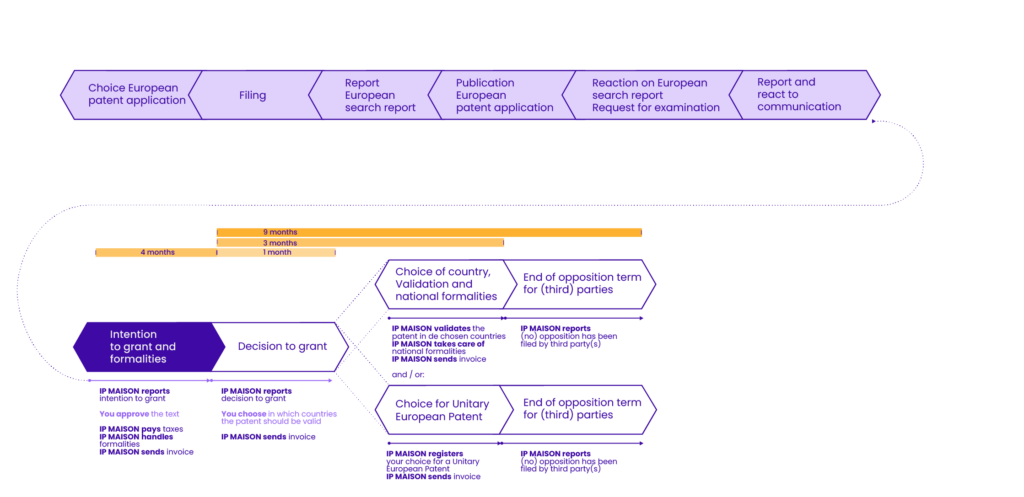
Normally, the European Patent Office eventually indicates its intention to grant a patent. We will provide you with the text of the patent application and, if you agree, we will ensure that the grant fee is paid and that German and French translations of the claims are submitted. As soon as that has happened, the European Patent Office will send a decision to grant.
Patent grant and country selection
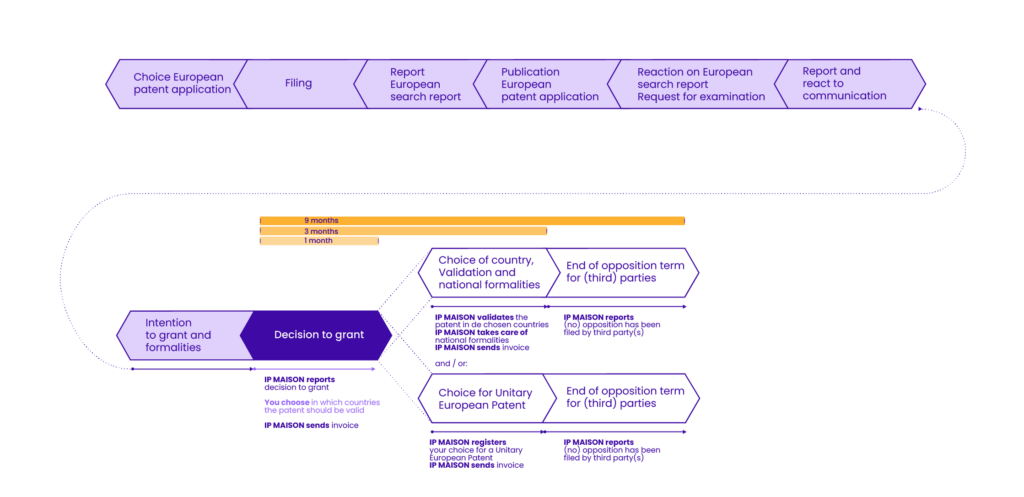
As soon as the decision to grant has been taken, the European patent is a fact.
Within one month of the grant of a European patent, it must be indicated whether the European patent will become a unitary European patent, a classic European patent in the form of a bundle of national patents or a combination of both. More information about making a choice between a Unitary European patent or a classic European patent can be found here.
If you opt for a Unitary European patent, we will take care of the formal registration of that choice.
If you opt for a bundle of national patents, the European patent will take effect in Belgium, Germany, France, the United Kingdom, Ireland, Luxembourg and Switzerland-Liechtenstein.
In those countries where the patent-granting authority may send correspondence after the European patent has been granted, we ensure that we or a foreign patent office are registered as an address of service for correspondence.
The patent will then take effect in Belgium, Germany, France, the United Kingdom, Ireland, Luxembourg and Switzerland-Liechtenstein, without any further translation obligations or additional taxes being applicable.
In the other countries, the granted patent must first be validated before it takes effect. Validation means that certain formalities, such as registering a national representative, paying validation fees and submitting a translation, are fulfilled.
The national fees as well as the translation costs differ per country, because in some countries there is an obligation to translate only the claims , while in others the entire patent text must be translated. Some countries have several accepted national languages. We naturally ensure that as few translations as possible have to be made by making the most convenient possible choice per country.
End of opposition period for (third) parties
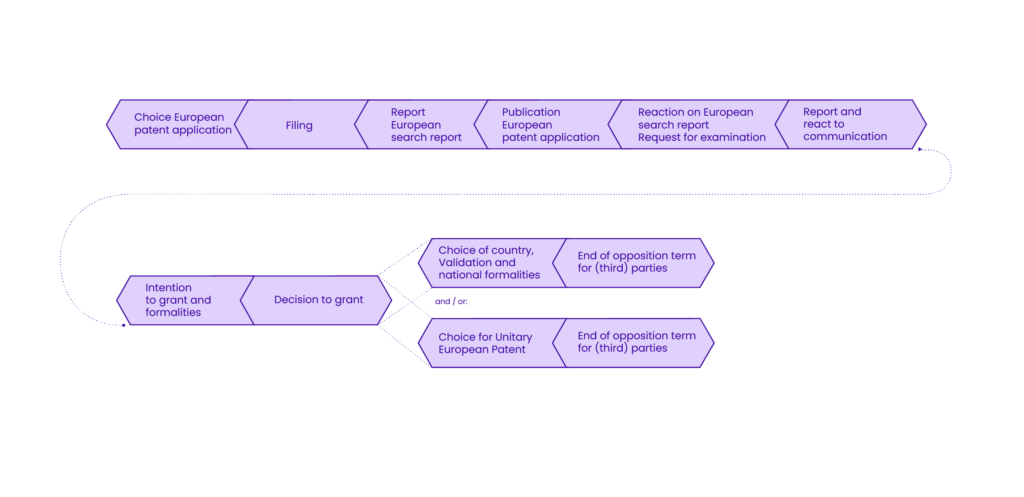
From the moment of the publication of the grant of a European patent, there is a period of 9 months during which it is possible for third parties to object to the grant of the patent. Such a procedure is called opposition, in which the opponent must provide substantiated evidence why, in his opinion, the patent has been wrongly granted. This may be because a publication with which the European Patent Office was not aware has not been taken into account, or because the patented object (for example by the opponent) was already marketed before the patent was applied for. If an opposition is filed, we will inform you and determine how to respond. If no opposition has been filed after nine months, we will also inform you of this.
Legenda

The central bar, running from left to right, maps out the procedure being followed.

The dark purple oval marks the stage we have currently reached in the procedure.

A pale purple oval indicates a completed stage.

A white oval shows a future stage.

A white oval with a dotted line indicates that a step is optional.

A sand timer denotes that an agreement, or official documents, for example, are pending.

This step may need to be completed several times.

Any fixed periods
are marked above the central bar.

This stage is carried out by IP Maison.

This stage is carried out by the client.